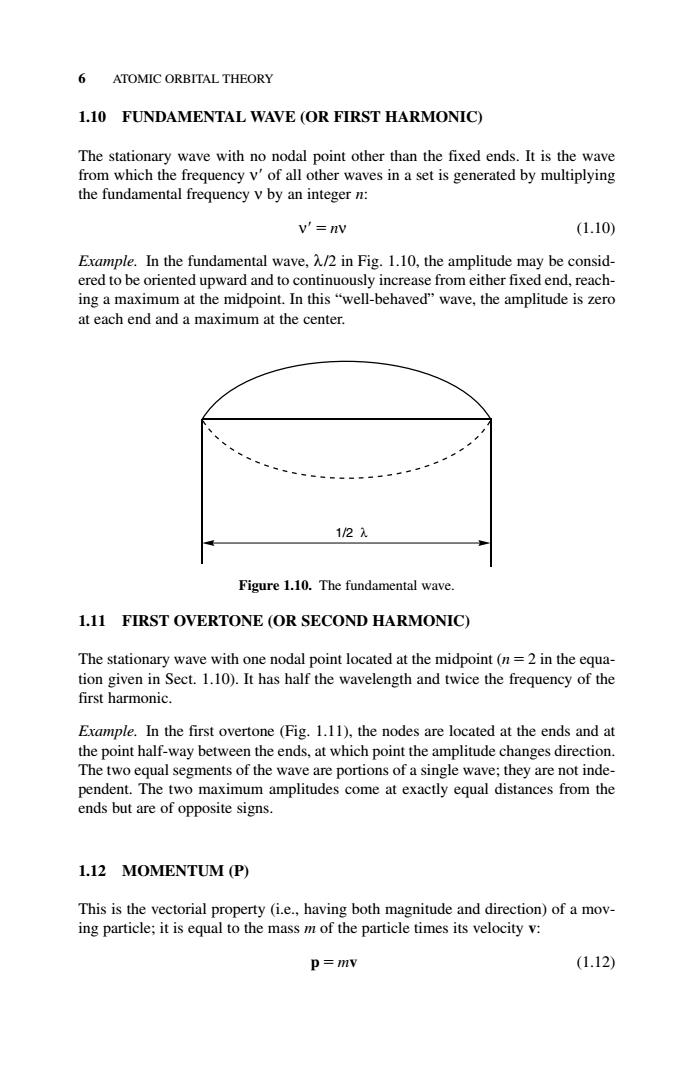正在加载图片...

6 ATOMIC ORBITAL THEORY 1.10 FUNDAMENTAL WAVE (OR FIRST HARMONIC) The stationary wave with no nodal point other than the fixed ends.It is the wave from which the frequency 'of all other waves in a set is generated by multiplying the fundamental frequency vby an integer n: v'=nv (1.10) Example.In the fundamental wave,in Fig.1.10,the amplitude may be consid ered to be oriented upward and to continuously increase from either fixed end,reach- ing a maximum at the midpoint.In this"well-behaved"wave,the amplitude is zero at each end and a maximum at the center. 12 Figure 1.10.The fundamental wave 1.11 FIRST OVERTONE (OR SECOND HARMONIC) The stationary wave w vith one nodal point located at the midpoint(n=2 in the equa tion given in Sect.1.10).It has half the wavelength and twice the frequency of the first harmonic. Example.In the first overtone (Fig.1.11),the nodes are located at the ends and a the point half-way between the ends,at which point the amplitude changes direction The two equal segments of the wave are portions of a single wave;they are not inde pendent.The two maximum amplitudes come at exactly equal distances from the ends but are of opposite signs. 1.12 MOMENTUM (P) This is the vectorial property (i.e.,having both magnitude and direction)of a mov- ing particle:it is equal to the mass m of the particle times its velocity v: p=mv (1.12) 1.10 FUNDAMENTAL WAVE (OR FIRST HARMONIC) The stationary wave with no nodal point other than the fixed ends. It is the wave from which the frequency ν of all other waves in a set is generated by multiplying the fundamental frequency ν by an integer n: ν nν (1.10) Example. In the fundamental wave, λ/2 in Fig. 1.10, the amplitude may be considered to be oriented upward and to continuously increase from either fixed end, reaching a maximum at the midpoint. In this “well-behaved” wave, the amplitude is zero at each end and a maximum at the center. 1.11 FIRST OVERTONE (OR SECOND HARMONIC) The stationary wave with one nodal point located at the midpoint (n 2 in the equation given in Sect. 1.10). It has half the wavelength and twice the frequency of the first harmonic. Example. In the first overtone (Fig. 1.11), the nodes are located at the ends and at the point half-way between the ends, at which point the amplitude changes direction. The two equal segments of the wave are portions of a single wave; they are not independent. The two maximum amplitudes come at exactly equal distances from the ends but are of opposite signs. 1.12 MOMENTUM (P) This is the vectorial property (i.e., having both magnitude and direction) of a moving particle; it is equal to the mass m of the particle times its velocity v: p mv (1.12) 6 ATOMIC ORBITAL THEORY 1/2 λ Figure 1.10. The fundamental wave. c01.qxd 5/17/2005 5:12 PM Page 6